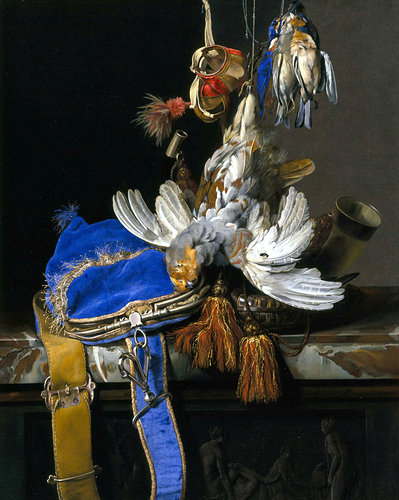Pronks for the Memory: Rendering Luxury
Still-life painting bloomed as never before in the Netherlands in the 17th century, and among its most vibrant and coveted blossoms were those of Willem van Aelst (1627-83). He is the subject of “Elegance and Refinement: The Still-Life Paintings of Willem van Aelst,” a small, intense exhibition of 28 paintings at the National Gallery of Art here.

Willem van Aelst's "Hunt Still Life With a Velvet Bag on a Marble Ledge" (about 1665), at the National Gallery. Sarah Campbell Blaffer Foundation, Houston.
A craftsman of extraordinary skill, van Aelst painted the sorts of objects customary among his fellow still-life producers: flowers in ornate, precious vases; ripe fruit; dead game animals; and hunting gear. He worked in various sizes. “Pronk Still Life With Armor” (about 1651), which measures about 6 ½ by 5 ½ feet, is a spectacularly radiant picture of gleaming metal ware, including weaponry, body armor, a trumpet and decorative objects arranged on a massive table and a chair sumptuously upholstered in gold-fringed red velvet.
His most impressive works, however, are more modestly scaled. About 26 by 21 inches, “Hunt Still Life With a Velvet Bag on a Marble Ledge” (about 1665) proffers a nearly microscopic study of diverse textures: the feathers of a gray partridge hanging upside down with splayed wings like a fallen angel; the soft, blue velvet fabric of a hunter’s sack with its bright silver buckles and catches. Heaped on a forward edge of a smooth stone slab, it all seems to spill forth into the viewer’s space in startling trompe-l’oeil style.
The word pronk that appears in numerous van Aelst titles referred to the types of objects he painted. They were things of conspicuous expense that only the wealthy could afford. That includes cut flowers, fresh fruit and dead game animals, since recreational hunting was reserved by law only for the aristocracy. Paintings like van Aelst’s were pronks as well: pronks picturing pronks. In “Still Life With Fish, Bread and a Nautilus Cup” (1678), humble foodstuff, including a rather gross cut-up herring on a silver plate, accentuates the richness of a red satin tablecloth and a silver statuette of Orpheus serving as the base for a large nautilus shell. Working for an upscale market, van Aelst was no populist.
Born in Delft, van Aelst studied with his uncle, the still-life painter Evert van Aelst, and, unusually for a Netherlander, spent time in the artist community of Paris as a teenager. In his 20s he went to Florence, where his paintings were acquired by the Medicis Cosimo III and Leopoldo. Evidently a prideful, contentious and possibly bibulous character, he left Italy after nearly killing a man in a fight. He returned to the Netherlands at 30 and settled in Amsterdam, where he prospered, married, had children and remained for the rest of his life.
Today’s viewers may find van Aelst’s paintings fusty, unlike those of his contemporary Vermeer. Seen as examples of the vanitas genre, with soon-to-wilt flowers warning of the fleetingness of life, they may seem to belong to an obsolete moral universe. A golden pocket watch in several works seems to affirm notions of time passing, extinguishing life as it goes.
In her catalog essay, however, the art historian Julie Berger Hochstrasser suggests another, more intriguing perspective. She points out that the pocket watch was a technological novelty in van Aelst’s time, and that all kinds of other instruments — barometers, thermometers, microscopes, telescopes and other tools for measurement, observation and navigation — were being patented “as scientific principles were applied to indigenous resources of expert craftsmanship.” She also relates van Aelst’s exacting rendering of flowers to scientific, botanical illustration practiced then in the service of expanding empirical knowledge. Ms. Hochstrasser does not mention it, but I would not be surprised to learn that van Aelst used some sort of newfangled optical device like the camera obscura to achieve his often nearly photographic verisimilitude.
It seems to me noteworthy too that another of van Aelst’s contemporaries was the philosopher and lens grinder Baruch Spinoza (1632-77), who also lived in Amsterdam. Spinoza’s theory that God and the material universe were completely coextensive struck some in his time as dangerously close to atheism. Van Aelst’s dates also overlapped with those of the French philosopher René Descartes (1596-1650), who wrote all of his most important works while living in the Netherlands. Descartes revolutionized thinking about the nature of human consciousness and its relationship to external reality by attending with excruciating care to his own experience of the world. Whether or not van Aelst was well versed in his time’s scientific and philosophical developments, his exacting attention to visual experience aligns him with a burgeoning age of skeptical, irreligious reason and scientific naturalism.
Van Aelst’s critics regularly noted a certain bipolarity in his paintings: while they were manifestly objects of extraordinary artifice, the viewer experiences the things they depict as uncannily present, as if they were hallucinated. In his catalog essay Arthur K. Wheelock Jr., organizer of the show and the National Gallery’s curator of northern Baroque painting, quotes one critic who declared that van Aelst “knew how to imitate life so naturally, that the work of his brush seemed to be no painting but life itself.”
Van Aelst was not unique in his ability to affect viewers in this paradoxical way, but he was exceptionally good at it. In examining his work, we might ask ourselves: Why is it that we have this susceptibility to illusory imagery, which iconoclasts of many different stripes fear and try to repress? Does it serve some evolutionary purpose? I do not know, but I suspect that without it there would be no art.
By Ken Johnson
Source: http://www.nytimes.com